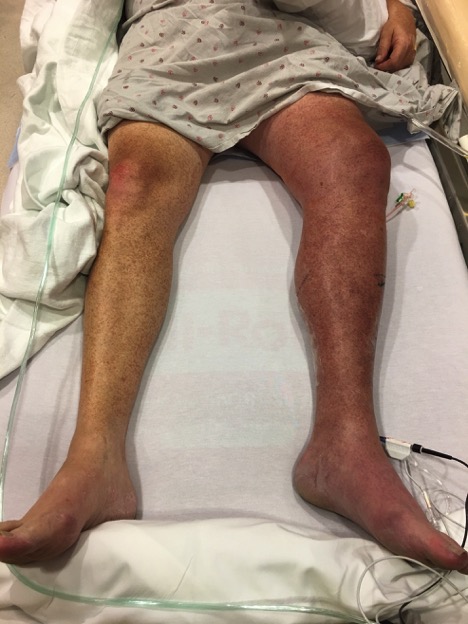Squamous Cell Cancer Encasing Iliac Vessels with Associated Phlegmasia and Compartment Syndrome
Whitney Thorne, DO, Brian Kuhn, MD, Matt Recht, MD, Patrick Muck, MD, Aaron Kulwicki, MD.
TriHealth/Good Samaritan Hospital, Cincinnati, OH, USA.
DEMOGRAPHICS:
The patient is a 67 year old Caucasian male former smoker with BMI 36 with history of prostatectomy for prostate cancer.
HISTORY:
The patient was transferred to our hospital with phlegmasia cerulea dolens with evidence of left iliofemoral DVT.
PLAN:
Endovascular approach with initiation of thrombolytic therapy via a popliteal approach.
DISCUSSION:
The patient was started on left lower extremity thrombolytic therapy via a popliteal approach without difficulty. However, the next morning, he was significantly worse with interval development of compartment syndrome. Thrombolytic therapy was stopped and he was taken to the operating room for open venous thrombectomy, creation of and AVF between the left GSV and the left SFA, venogram, retrograde stenting of the left CIV with a Wallstent four compartment fasciotomy of the lower leg, and left lateral thigh fasciotomy. Subsequent CT demonstrated a mass encircling the left CIV and left CIA. Biopsy was positive for squamous cell carcinoma. He was started on chemotherapy. The fasciotomies were closed and he underwent chemotherapy. Six months later he underwent en bloc resection the tumor involving the left kidney, CIV, CIA, and ureter. The artery and vein were reconstructed with cryopreserved femoral vein. Postop he developed a urinoma that required drainage. Three weeks after the initial surgery he suffered a cardiac arrest secondary to hemorrhage and he was taken back to surgery where it appeared the drain had eroded into the interposition CIA cryovein. Because the patient was in extremis, the CIA was ligated proximally and distally. The patient survived without acute limb ischemia, however did have lifestyle limiting claudication which did not improve after eight months of conservative therapy. Therefore, we performed a right CFA to left SFA bypass. At last visit, 3 months post op, his is doing well with complete resolution of the claudication and is golfing again. 
Back to 2019 ePosters
